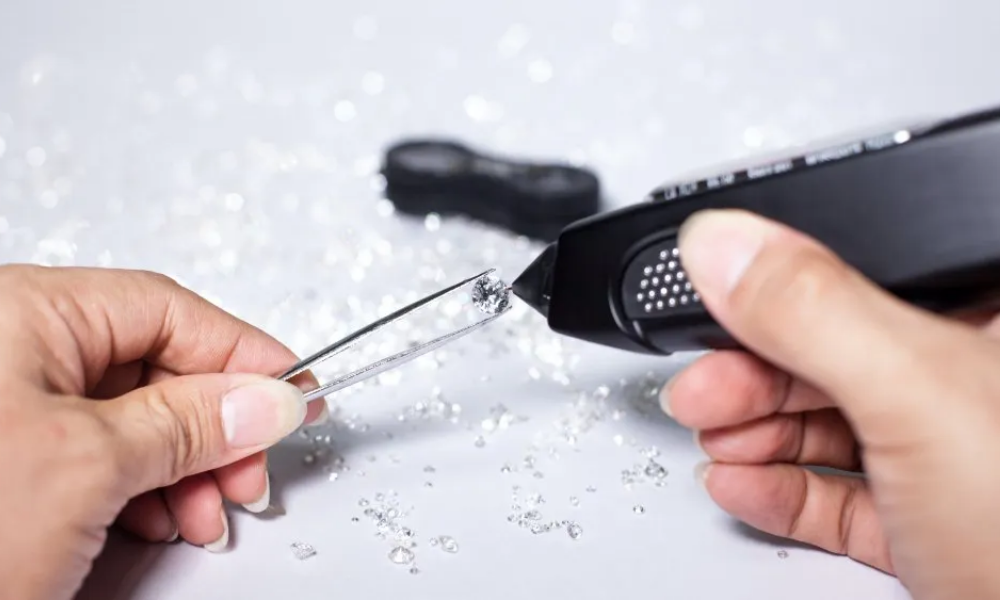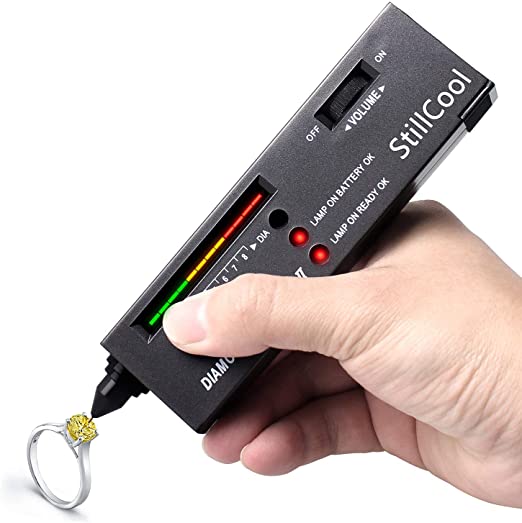You’ve come to the right site if you’re looking for information on utilizing a diamond tester. There are several different types of these devices in today’s market, and utilizing one is very straightforward. Most models are simple to operate, requiring only a few buttons to do the task. Some have an automated shut-off feature and a fast LCD, making them simple to use even for unskilled individuals.
Using a Diamond Tester, you may adequately detect whether a gemstone is a diamond or a diamond stimulant by measuring the heat conductivity of the gemstone. This diamond tester will not distinguish between natural Moissanite and synthetic Moissanite, which has a thermal conductivity identical to that of a diamond. When utilizing a diamond tester, please ensure that you are using it properly.
What is a Diamond Tester?
A diamond tester can be characterized as a compact, a portable gadget with a needle-like tip to test the gemstones for inclusions and inclusions.
The needle-like tip of the gadget is put on the gemstone to be tested, and if the gemstone being tested is made of genuine diamonds, the device will illuminate or emit a signal to indicate if the stone is genuine or not.
How to Use a Diamond Tester?
It is possible to use a diamond tester to evaluate the chemical makeup of a gemstone and the thermal and electrical conductivity of the gemstone. A heat test is highly significant since Moissanite, a form of diamond simulant, does not withstand high temperatures and can be challenging to identify using a heat test. Modern diamond testers incorporate heat and electrical testing and the ability to identify whether or not the stone is placed in a metal setting, among other features. If you think you’re getting a fake stone because of the metal mounting, use a metal detector to ensure you’re getting the real thing.
How to Get Ready to Use the Diamond Tester:
- Open the battery cover by sliding it open in the direction of the arrow.
- Insert the 9V battery into the slot.
- Slide the power switch until it hits the Diamond setting on the LCD screen.
- The power bulb will illuminate in solid red, while the adjacent ready bulb will flash green in response to the power bulb.
- Wait approximately 30 seconds for the testing probe to get warm.
- A solid green flash and a short beep indicate that the power-on cycle has been completed when the ready bulb illuminates solidly.
- Please check that the LED level meter is illuminated up to the second column (if not, please adjust the volume control until the bar light is illuminated up to the second column). Then you can begin testing the system.
Testing
- Always thoroughly clean the stone before performing any tests.
- Remove the protective cap from the tip of the probe with care.
- Hold the diamond tester with your right hand so that your index finger rests on the electricity-conducting panel on the top of the diamond tester.
- Press the probe tip onto the top of the stone at a right angle (as shown in the example). It would help if you never pressed the tester on a stone at an angle other than 90 degrees.
- Warning: Excessive force may cause the probe tip to break or bend.
- When evaluating stones that have already been placed, use your left hand to hold the settings.
- When testing loose stones, the best results are obtained when the stone is placed in the testing base. With one hand, you can secure the testing base.
How Should the Test Results be Interpreted?
- According to the manufacturer, if the LED illuminates in the red zone, resulting in three beeps, it indicates that the stone you are examining is a genuine diamond. When it just illuminates the green or/and yellow zones, however, likely, the stone is not a diamond or, at the very least, a synthetic diamond, according to the American Gem Society. (See the video below for further information.) It’s a piece of cake!
- It is important to note that the tester will emit a continuous beep if the probe tip comes into touch with a metal.
- Depending on the type of diamond being tested, it is generally advised to test diamonds between 64 and -84 degrees Fahrenheit.
- It is recommended to withdraw the tester from its settings if you are testing a little stone less than 0.5ct in weight, and this will allow the probe to cool down before using the tester again. In addition, you should take advantage of the volume control located at the third bar to achieve more precise readings.
- The visual and aural signals provided by the tester will provide you with all of the information you require regarding the nature of the test material.
If You’re Still Confused about What to Look for When Utilising the Tester, Here’s What You Should Know:
- This indicates that the test stone is a diamond if there are three beeping sounds.
- At least one red bar on the meter level for larger stones indicates the presence of diamonds – mainly when a large number of red bars illuminate.
- A simulated diamond is used as a test material if no beeping sound is produced throughout the test. This holds even if there aren’t any red bars that are illuminated.
- In the instance of continuous buzzing, you’d be testing a metal, or the probe tip would be in contact with metal, and you’d want to disconnect the tip and move it to the stone to stop the buzzing.
- The detector will also go up to 8 on the loudness level if you’re testing sapphires or rubies, for example.
When it Comes to Diamond Testers, There are a Few Other Things to Bear in Mind:
- It’s crucial to remember that the diamond tester is designed to detect the moisture levels on your hands, so if you’re wearing a glove or your hand/skin is too dry; it won’t perform as effectively.
- It is best to hold the stone jewelry in your left hand if it is set in a metal setting when you are evaluating it.
- If you test the same stone too many times, it will become heated, and the results on the tester will indicate that it is not a diamond, even if the diamond is, in fact, a diamond. As a result, you should avoid testing the stone too frequently, and if it does heat up, you should allow it to cool for around 3 minutes.
- When you have finished evaluating the gems, please turn off the tester and place it back in the case for safekeeping. Avoid exposing the tester to humidity or dust to get the most out of it over the long haul. This is because the tester contains high-precision electrical circuits that would be damaged if exposed to the elements. It is also recommended that you never open any of the other elements of the tester until you open the battery compartment.
still cool Diamond Tester, High Accuracy Dimond Test Pen, Professional Jeweler Diamond Tester Tool
Features
- LCD display & LED indicator.
- It is designed for quick, precise, and safe diamond testing.
- A portable electronic device for distinguishing real diamonds from other simulated stones.
- If the stone is a Fake crystal, a simulant such as cubic zirconium ( CZ ), will be no reaction.
- Powered by DC 9V battery x 1 (Not Included)
When a Diamond Tester Turns Blue, What does it Mean?
The SSEF Diamond Tester For Blue and Potentially Blue Diamonds allows you to determine whether a diamond is type IIb. A straightforward tool that EVERY RETAILER should have on hand at the counter.
A different method of determining whether or not a diamond is genuine is to expose it to ultraviolet light and observe the reaction. The majority of diamonds, although not all, will emit a blue-tinted glow, and some diamonds do not glow when exposed to ultraviolet light. As a result, even if the stone does not emit any light, the results do not always imply that it is a synthetic diamond.
Is Diamond Tester a Reliable Tool?
Diamond testers are highly accurate instruments, and they aid in identifying genuine diamonds at precisely the right time. Unfortunately, when Moissanite is present, thermal conductivity testing can be inaccurate, and this is because Moissanite and diamond conduct heat at approximately the same rate.
Is it Possible for a Fake Diamond to Pass a Diamond Tester?
Is it possible for artificial diamonds to pass a diamond tester? Some diamond simulants can pass through a diamond tester with flying colors. For example, Moissanite, an artificial stone, may appear as a diamond when tested with a conventional tester pen. This is since Moissanite has a very high thermal conductivity.
When tested using a diamond tester, lab-grown diamonds come back positive because they comprise crystalline carbon, much like mined diamonds. However, because some high-pressure, high-temperature diamonds may include imperfections (which are not visible to the human eye), there is a potential that they will test as Moissanite or non-diamond.
With a Flashlight, How can you Tell if a Diamond is Real?
Place the loose diamond close to a light source, such as a lamp, and see the reflection of the light from within the diamond. This test will be most effective if you have another gem to compare to, such as cubic zirconia, to make the comparison easier. You’ll see how their effects differ from those of light.
Genuine diamonds do not have a rainbow of hues within the stone, as is commonly believed. The interior of actual diamonds, on the other hand, glows in shades of white and grey. The diamond’s brilliance comes from the way it reflects light.
Conclusion
The diamond tester may be a good option for you if you are unsure whether the ring you recently purchased is composed entirely of diamonds or entirely of diamond simulants. The techniques outlined above will allow you to test the diamond jewelry with ease and high precision.
Diamond testers are available in two basic configurations. In the first case, a heat-powered model is used. Heat is used to generate thermal conductivity, and the quality of the reading is calculated depending on how quickly heat is transferred through the diamond. The second type is electrically operated, and it is more accurate than heat testers in terms of temperature. Both types of testers can detect diamonds and Moissanite, although the electricity tester will be more expensive. In general, however, the most accurate testers are powered by electricity.










